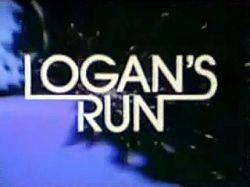Logan's Run - the TV Series
Base of Galactic Science Fiction :: SCIENCE FICTION in TELEVISION :: Bronze Age of TV Science Fiction
Page 1 of 1
 Logan's Run - the TV Series
Logan's Run - the TV Series
Logan's Run aired on TV from September, 1977 to January, 1978

The TV series known as Logan's Run was based on the film of the same name from 1976; the film itself was based on a sixties sf novel by William F. Nolan and George Clayton Johnson. The series was produced by Ivan Goff and Ben Roberts, who followed most of the same premise as the film, with some interesting differences. When the new series was mentioned in the 9th issue of Starlog (October, 1977), it was thought to perhaps become the most successful TV SFer since Star Trek. It didn't turn out that way, lasting only 14 episodes, some of which never even aired on the west coast of the USA. The pilot episode, ending up as a longer 90-minute episode, utilized stock footage from the big-budget film for most of the city shots.

The TV series known as Logan's Run was based on the film of the same name from 1976; the film itself was based on a sixties sf novel by William F. Nolan and George Clayton Johnson. The series was produced by Ivan Goff and Ben Roberts, who followed most of the same premise as the film, with some interesting differences. When the new series was mentioned in the 9th issue of Starlog (October, 1977), it was thought to perhaps become the most successful TV SFer since Star Trek. It didn't turn out that way, lasting only 14 episodes, some of which never even aired on the west coast of the USA. The pilot episode, ending up as a longer 90-minute episode, utilized stock footage from the big-budget film for most of the city shots.
 Similar topics
Similar topics» Ark II series
» Superman the Series
» Masters - a short series
» Batman the Series of Camp
» Planet of the Apes series (1974)
» Superman the Series
» Masters - a short series
» Batman the Series of Camp
» Planet of the Apes series (1974)
Base of Galactic Science Fiction :: SCIENCE FICTION in TELEVISION :: Bronze Age of TV Science Fiction
Page 1 of 1
Permissions in this forum:
You cannot reply to topics in this forum

